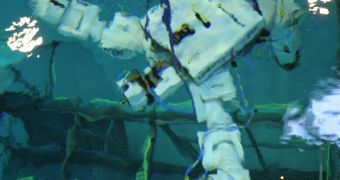Robotic applications like those seen in the sci-fi movies will soon become a reality, as future robots could take over some human professions, like low-tech construction workers, medical nurses, doing the chores for people or helping them in extreme environments.
The latest development in that direction is the Eurobot, an almost humanoid robot built by the European Space Agency that will help astronauts during spacewalks around the International Space Station.
It's a sophisticated machine that can operate in outer space and has just completed the trial period, where it performed various functions in a water tank simulating microgravity on and around the space station.
It's a multi-jointed three-armed assistant, designed to take over some of the tasks currently undertaken by astronauts. The possible applications don't stop here, since, if all goes well on the station, officials are considering signing it up for the future manned missions to the Moon and Mars.
Eurobot will never get tired, thus saving astronauts a great deal of time and effort by taking over various routine tasks. It will be remotely controlled by an operator inside the station and the three hands it possesses will prove very useful at multitasking.
"It could be a most useful aid," said Gianfranco Visentin, head of ESA's Automation and Robotics section. "There is a shortage of crew time during all missions, so anything that improves the use of astronaut time is very desirable."
The robot will be equipped with a camera on each hand and an end-effector effectively working a third hand. It will be able to move and manipulate objects and to recognize objects even in obscured locations, thus making it a valuable assistant for the astronauts.
"The tests went very well", said Philippe Schoonejans, ESA's Eurobot Project Manager. "Not only has it been demonstrated that Eurobot can walk around an orbital station autonomously and safely, using no more than the existing EVA handrails, it is also becoming clear that Eurobot can really help the astronauts. And in the next phase we also plan to demonstrate its use in on a planetary surface, as part of the Agency's exploration program."

 14 DAY TRIAL //
14 DAY TRIAL //